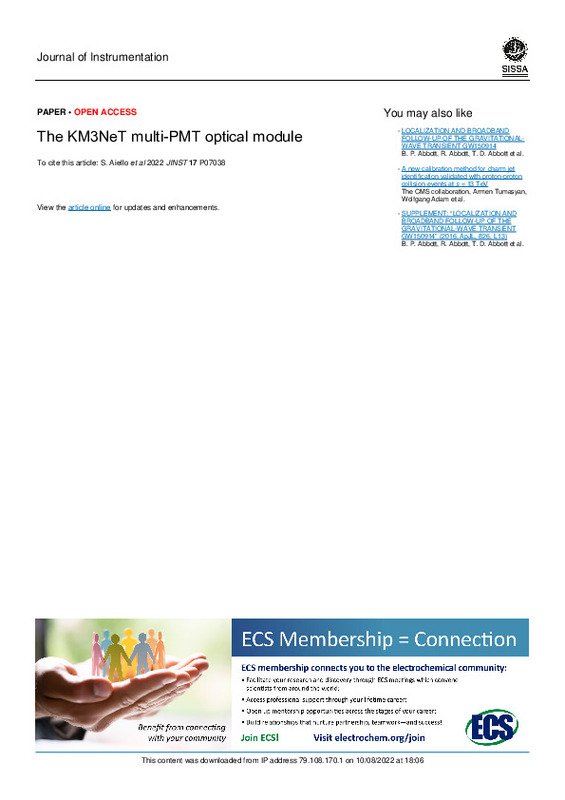|
Resumen:
|
[EN] The optical module of the KM3NeT neutrino telescope is an innovative multi-faceted
large area photodetection module. It contains 31 three-inch photomultiplier tubes in a single 0.44
m diameter pressure-resistant glass ...[+]
[EN] The optical module of the KM3NeT neutrino telescope is an innovative multi-faceted
large area photodetection module. It contains 31 three-inch photomultiplier tubes in a single 0.44
m diameter pressure-resistant glass sphere. The module is a sensory device also comprising
calibration instruments and electronics for power, readout and data acquisition. It is capped with
a breakout-box with electronics for connection to an electro-optical cable for power and
long-distance communication to the onshore control station. The design of the module was qualified
for the first time in the deep sea in 2013. Since then, the technology has been further improved to
meet requirements of scalability, cost-effectiveness and high reliability. The module features a
sub-nanosecond timing accuracy and a dynamic range allowing the measurement of a single photon up
to a cascade of thousands of photons, suited for the measurement of the Cherenkov radiation induced
in water by secondary particles from interactions of neutrinos with energies in the range of GeV to
PeV. A distributed production model has been implemented for the delivery of more than 6000 modules
in the coming few years with an average production rate of more than 100 modules per month. In this
paper a review is presented of the design of the multi-PMT KM3NeT optical module with a proven
effective background suppression and signal recognition and sensitivity to the incoming direction
of photons.
[-]
|
|
Agradecimientos:
|
The authors acknowledge the financial support of the funding agencies: Agence Nationale de la
Recherche (contract ANR-15-CE31-0020), Centre National de la Recherche Scientifique (CNRS),
Commission Européenne (FEDER fund ...[+]
The authors acknowledge the financial support of the funding agencies: Agence Nationale de la
Recherche (contract ANR-15-CE31-0020), Centre National de la Recherche Scientifique (CNRS),
Commission Européenne (FEDER fund and Marie Curie Program), Institut Universitaire de France
(IUF), LabEx UnivEarthS (ANR-10-LABX-0023 and ANR-18-IDEX-0001), Paris Île-de-France
Region, France; Shota Rustaveli National Science Foundation of Georgia (SRNSFG, FR-18- 1268),
Georgia; Deutsche Forschungsgemeinschaft (DFG), Germany; The General Secretariat of Research and Technology (GSRT), Greece; Istituto Nazionale di Fisica Nucleare (INFN), Ministero dell¿Università e della Ricerca (MIUR), PRIN 2017 program (Grant NAT-NET 2017W4HA7S) Italy;
Ministry of Higher Education, Scientific Research and Innovation, Morocco, and the Arab Fund
for Economic and Social Development, Kuwait; Nederlandse organisatie voor Wetenschappel¿k
Onderzoek (NWO), the Netherlands; The National Science Centre, Poland (2015/18/E/ST2/00758);
National Authority for Scientific Research (ANCS), Romania; Ministerio de Ciencia, Innovación,
Investigación y Universidades (MCIU): Programa Estatal de Generación de Conocimiento (refs.
PGC2018-096663- B-C41,-A C42,-B-C43,-B-C44) (MCIU/FEDER), Generalitat Valenciana: Prometeo (PROMETEO/2020/019), Grisolía (refs. GRISOLIA/2018/119,/2021/192) and GenT (refs.
CIDEGENT/2018/034, /2019/043,/2020/049,/2021/023) programs, Junta de Andalucía (ref. AFQM-053-UGR18), La Caixa Foundation (ref. LCF/BQ/IN17/11620019), EU: MSC program (ref.
101025085), Spain.
[-]
|









